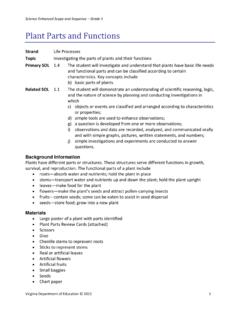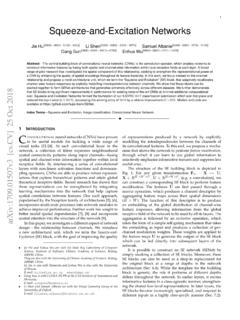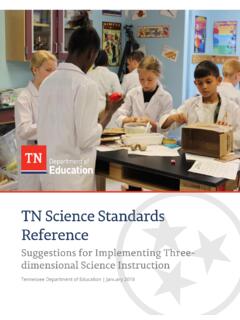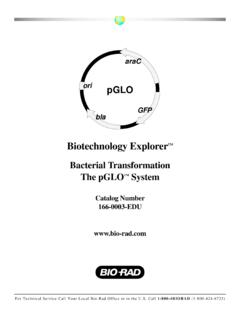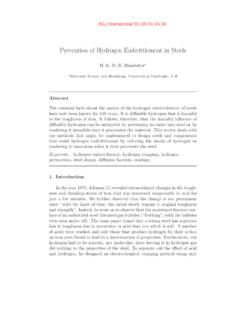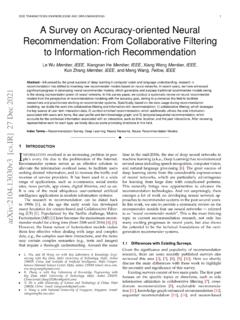Transcription of Dissolving Solids in Hot and Cold Water - VDOE
1 Science enhanced Scope and sequence Grade 1 Virginia Department of Education 2012 1 Dissolving Solids in Hot and Cold Water Strand Matter Topic Investigating Solids Dissolving in Water at different temperatures Primary SOL The student will investigate and understand how different common materials interact with Water . Key concepts include c) some Solids will dissolve more readily in hot Water than in cold Water . Related SOL The student will demonstrate an understanding of scientific reasoning, logic, and the nature of science by planning and conducting investigations in which b) observations are made from multiple positions to achieve a variety of perspectives and are repeated to ensure accuracy; c) objects or events are classified and arranged according to characteristics or properties; d) simple tools are used to enhance observations; e) length, mass, volume, and temperature are measured using nonstandard units.
2 F) inferences are made and conclusions are drawn about familiar objects and events; i) observations and data are recorded, analyzed, and communicated orally and with simple graphs, pictures, written statements, and numbers; j) simple investigations and experiments are conducted to answer questions. Background Information Sugar dissolves faster in hot Water than it does in cold Water because hot Water has more energy than cold Water . When Water is heated, the molecules gain energy and, thus, move faster. As they move faster, they come into contact with the sugar more often, causing it to dissolve faster.
3 Comparing a drop of liquid food coloring placed in a container of cold Water with a drop placed in a container of hot Water clearly demonstrates this concept. Materials Small beakers or other clear containers two for each station setup Water Hot pot for heating Water Five Solids about two tablespoons for each station in which they will be used: o Sugar o Salt o Powdered sweetener o Brown sugar o Baking soda Plastic spoons enough for two in each station setup One timer Science enhanced Scope and sequence Grade 1 Virginia Department of Education 2012 2 Dissolving Solids in Hot and Cold Water handout (attached) Results posters to display and guide experiment for class groups Student science journals Vocabulary dissolve Student/Teacher Actions (what students and teachers should be doing to facilitate learning) Introduction 1.
4 As a warm up, teach students this traditional sung nursery rhyme, using a chart: Pease Porridge Hot Pease porridge hot, pease porridge cold, Pease porridge in the pot, nine days old; Some like it hot, some like it cold, Some like it in the pot, nine days old. 2. After teaching and singing through the rhyme several times, explain that porridge is a kind of thick pudding that is still enjoyed by many people today. Pease porridge is actually made from dried peas and can be kept many days, as the song implies. Flavorings, such as bacon, are sometimes added to it. Ask whether any students have eaten split pea soup, which tastes similar to pease porridge.
5 Tell students that before microwaves and convenience foods were available, soups and porridges such as these were kept on stoves in many kitchens to use as a quick meal or snack. 3. Tell students that this lesson will not take nine days, but will show how some familiar substances can be mixed with hot and cold Water to see if the Water temperature effects how the substances dissolve. Procedure Prior to this activity, set up at least five workstations, each with two small beakers or other clear containers, two spoons, and one of the pairs of Solids listed under Materials. (If you need more than five workstations, multiple stations can have the same solid .)
6 The ideal group size is two to three students.) 1. Tell students that we will explore the question, Will hot Water make Solids dissolve easier and faster than cold Water ? Ask students how many like to help prepare foods in the kitchen. When cooking, have you noticed that heating foods can sometimes cause a special reaction that changes the food? Tell students that we will observe some of those changes when using some simple Solids and hot and cold Water to answer the question. 2. Divide the class into groups of two to three students, and direct each group to a workstation. Tell groups that that will test the solid found at their workstation.
7 Have each group identify their solid . 3. Give each group a copy of the attached Dissolving Solids in Hot and Cold Water handout, and go over it to explain what will happen. Answer any questions that may arise. 4. Heat the Water . CAUTION! Be certain that the Water is not hot enough to burn anyone. Fill each hot container halfway with hot Water and each cold container halfway with cold Water . Science enhanced Scope and sequence Grade 1 Virginia Department of Education 2012 3 5. Have groups carefully pour their Solids into the containers. As soon as the Solids are in the hot and the cold Water at all the stations, set the timer for three minutes and start the timer.
8 6. After three minutes, let the groups know that it is time to record their first observation about how their solid reacted in the hot Water and in the cold Water . Immediately reset the timer for three minutes and start the timer. While groups wait for three more minutes to elapse, have each of them write one sentence to describe what happened to their Solids during the first three minutes. (Students should observe that Solids in hot Water started to dissolve soon after being placed in the Water and that Solids in cold Water either took longer to start to dissolve or did not do so at all.)
9 7. After the second three minutes are up, have each group again observe their two containers and write what happened during the second three minutes. 8. Have each team discuss the initial question again ( Will hot Water make Solids dissolve easier and faster than cold Water ? ) and write their answer on their team Dissolving Solids in Hot and Cold Water handout. 9. As an additional test, have groups place a spoon in each container and gently stir. Does this help the Solids dissolve? Discuss this as a class. 10. Have groups take turns presenting the results of their experiment. Display each group s results so that all can observe them to compare and contrast findings.
10 Assessment Questions o Did hot Water have the same effect on all the Solids ? Why, or why not? o Did cold Water have the same effect on all the Solids ? Why, or why not? o Did stirring affect all the Solids in the same way? Why, or why not? Journal/Writing Prompts o Explain what happened in the two containers your group observed. Draw a picture of the activity. Name some things you know about this solid . o Describe how you might make Pease Porridge. Do you think it would taste best hot or cold? Why? Extensions and Connections (for all students) Mix liquid dish detergent with Water .










